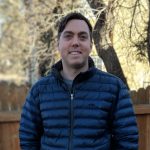
Timothy J. Stasevich
Colorado State University
Imaging Single-mRNA Translation Dynamics in Living Color
Abstract: My lab is creating technology to image mRNA translation in real time and with single-molecule precision in living cells. In this talk, I will introduce our technology and describe how it can be used to amplify fluorescence from newly synthesized proteins as they are being translated from single mRNAs. I will show how we quantify these signals to determine the size, shape, subcellular localization, and mobilities of mRNA translation sites, as well as their protein synthesis dynamics. I will then highlight a few recent applications of our technology, focusing mainly on a new biosensor we have developed to quantify how individual regulatory factors impact single mRNA translation dynamics. Using this biosensor, we provide evidence that human Argonaute2 (Ago2) shuts down translation by down regulating translation initiation on the minutes timescale and helping usher translationally silent mRNAs into P-bodies on the hours timescale. I will conclude by discussing new fluorescent intrabodies my lab is engineering to light up nascent and mature proteins in multiple colors. As these intrabodies can be encoded on plasmids, they can easily be adapted by other labs to image gene activity in diverse living systems.
Biosketch: Timothy J. Stasevich is an Associate Professor in the Department of Biochemistry and Molecular Biology at Colorado State University (CSU). His lab uses a combination of advanced fluorescence microscopy, genetic engineering, and computational modeling to study the dynamics of gene regulation in living mammalian cells. His lab helped pioneer the imaging of real-time single-mRNA translation dynamics in living cells [1]. Dr. Stasevich received his B.S. in Physics and Mathematics from the University of Michigan, Dearborn, and his Ph. D. in Physics from the University of Maryland, College Park. He transitioned into experimental biophysics as a post-doctoral research fellow in the laboratory of Dr. James G. McNally at the National Cancer Institute. During this time, he developed technology based on fluorescence microscopy to help establish gold-standard measurements of live-cell protein dynamics. Dr. Stasevich next moved to Osaka University, where he worked with Dr. Hiroshi Kimura as a Japan Society for the Promotion of Science Foreign Postdoctoral Research Fellow. While there, he helped create technology to image endogenous proteins and their post-translation modifications in vivo. This allowed him to image the live-cell dynamics of epigenetic histone modifications during gene activation for the first time [2]. Before joining the faculty at CSU, Dr. Stasevich spent a year as a Visiting Fellow at the HHMI Janelia Research Campus, where he applied super-resolution fluorescence microscopy to improve the spatiotemporal resolution of endogenous protein imaging in live cells.
1. Morisaki, T. et al. Real-time quantification of single RNA translation dynamics in living cells. Science 352, 1425–1429 (2016).
2. Stasevich, T. J. et al. Regulation of RNA polymerase II activation by histone acetylation in single living cells. Nature 516, 272–275 (2014).